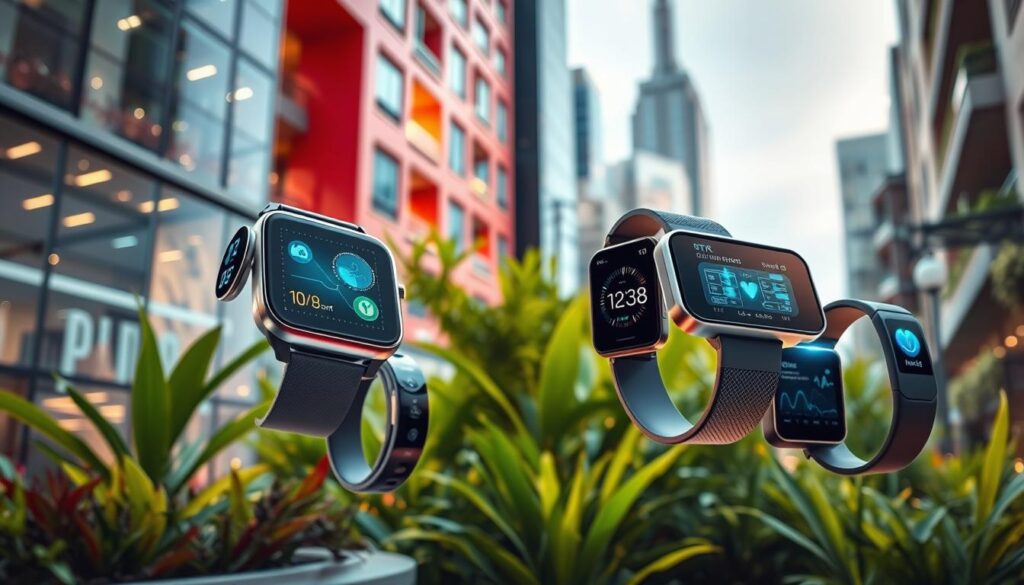We’re diving into the world of wearable technology, where smart wearables are transforming our lives. Devices like fitness trackers and smartwatches are everywhere. They’re not just for tracking steps anymore. They’re changing how we live and interact with the world.
As we explore, we’ll look at the latest trends and what’s coming next in wearable tech. Our aim is to give you a full guide on wearable devices and their uses. We want to show how these technologies can improve our daily lives. With the wearable tech industry growing fast, it’s key to keep up with new advancements.
Key Takeaways
- Wearable technology is a rapidly growing industry with a wide range of applications.
- Smart wearables, such as fitness trackers and smartwatches, are popular types of wearable devices.
- Wearable devices offer various benefits, including tracking fitness and health metrics.
- The future of wearable technology holds much promise, with advancements in fields like augmented reality and artificial intelligence.
- Staying informed about the latest developments in wearable technology is essential for making the most of its benefits.
- Wearable devices have the power to revolutionize how we live and interact with our surroundings.
Getting Started with Smart Wearables: Essential Knowledge
Exploring wearable devices is exciting. We’ll look at the different types, like fitness trackers and smartwatches. You’ll learn what to check for, like how well they work with your phone and how long they last.
When picking a wearable, think about a few things:
- How well it works with your phone or other devices
- How long the battery lasts and how to charge it
- The accuracy of its sensors, like heart rate or GPS
Wearables, like fitness trackers and smartwatches, do a lot. They track your activity and send you notifications. Knowing what each device can do helps you choose the right one for you.
![]()
Setting up your new wearable is important. We’ll guide you through it step by step. Whether you want a basic fitness tracker or a smartwatch, we aim to help you start using smart wearables easily.
Wearable Technology: Maximizing Your Device’s Potential
We’re excited to dive into the world of wearable tech and how it can change our daily lives. With so many gadgets out there, it’s key to know how to get the most out of them. Wearable tech lets us track fitness, health, and get notifications right on our wrists or other devices.
Wearable tech offers many benefits. It boosts our motivation to stay active, helps us monitor our health, and keeps us connected. To make the most of our gadgets, here are some tips:
- Set clear fitness goals and track progress using wearable tech
- Monitor health metrics, such as heart rate and sleep patterns
- Customize notification settings to stay connected without distractions

By following these tips and checking out different gadgets, we can unlock wearable tech’s full power. Whether it’s smart clothes or accessories, the options are endless. We’re eager to see how wearable tech will keep improving our lives.
The Future of Smart Living: Taking Your Wearable Experience to the Next Level
Wearable technology is key in the future of smart living. Fast progress in sensor technology, artificial intelligence, and the Internet of Things (IoT) is making smart living smoother. We see a future where our wearable devices are part of our daily lives, giving us insights, boosting productivity, and changing how we interact with our surroundings.
Smart wearables have endless uses, from health and fitness to entertainment and home control. Picture a world where your wearable tracks your health, suggests workouts, and calls for help in emergencies. With wearable technology and smart homes, we can create intelligent spaces that meet our needs and automate tasks, making life easier.
We’re thrilled about the smart wearable revolution and its impact on smart living. Wearable devices can improve our health, boost productivity, and change how we connect with digital worlds. The future is here, and it’s time to explore the amazing possibilities of smart living.











Leave a Reply